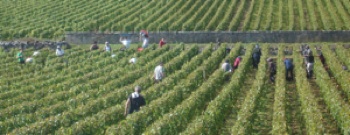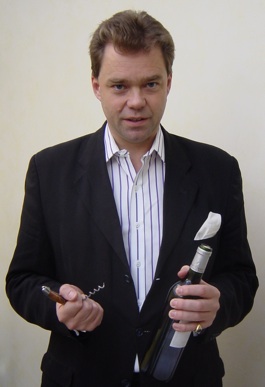White Mischief

Harvesting Montrachet 23rd September 2010.
In the world of dry white wine it is safe to say that there is no style more exalted than white Burgundy. It represents (or at least should represent) the pinnacle of the winemaker’s art. The most prized wines come from the Côte de Beaune, the southern half of the Côte d’Or, which is home to Montrachet, a vineyard whose cheapest wines start at about €300 per bottle before moving swiftly upwards. This wine has enchanted wine lovers for centuries with Alexandre Dumas suggesting that it should be, “drunk kneeling and with one’s head bared.” Lying nearly contiguous to Montrachet is a clutch of other grand crus: Chevalier-Montrachet, Bâtard-Montrachet, Bienvenues-Bâtard-Montrachet and Criots-Bâtard-Montrachet. They are not quite so fabled but you still need to draw breath before buying a bottle. All of these vineyards lie within the village boundaries of Chassagne- and Puligny-Montrachet. Just up the road is Meursault, famed for premier crus such as Les Perrières, Les Genevrières and Les Charmes.
Further along still we come to the splendid hill of Corton, swathed with vines and home to Corton-Charlemagne, named, so it is said, when the emperor’s wife made him switch to white wine because red was staining his beard. But enough of dewy-eyed legend. All is not well with white Burgundy and has not been for 15 years or so. (As an aside it should be remembered that there are many other areas within Burgundy that produce white wine such as Chablis, the Côte Chalonnaise, the Mâconnais and other vineyards within the Côte d’Or, but the Côte de Beaune is the heartland, the source of the greatest wines.)

The hill of Corton.
Starting with the 1995 and ’96 vintages, which were both well regarded at the outset, it became clear in the early years of this century that many of the wines were showing alarming signs of ageing, if not outright deterioration. News such as this will spread more slowly than the normal vintage assessments that are published when the wines are first released. These are eagerly scrutinised before decisions to buy or not to buy are made. Thus 1995 and ‘96 lodged initially in the collective conscience as good vintages. Gradually, however, more and more people reported disappointment with the wines, usually once they were over five or six years of age. The problem was premature oxidation, now shortened to premox (say prem-ox, not pre-mox, or just give into temptation and say pox’d).
Since then it is no exaggeration to say that a storm of debate has raged, some erudite and some understandably vituperative. But with no obvious villain the talk has tended to go around in circles without reaching any definitive conclusion. What caused the problem and, much more pertinently, what could solve it? These are questions to which satisfactory, clear and unequivocal answers, which are agreed upon by all, remain elusive.
It is generally agreed that many winemaking practices changed in the 1990s, usually in an effort to make clean, ‘unadulterated’ wine, that is to say wine made as naturally as possible, with minimal intervention from the winemaker. The use of sulphur, in the form of sulphur dioxide, came under increasing scrutiny. Sulphur is used principally as a preservative and successful winemaking is almost impossible without it. Wines with very low doses of sulphur, or none at all, can be unstable and are prone to spoilage. It is used more in white wines than reds because reds have tannin, which is an anti-oxidant, to help preserve them. Sweet wines require higher doses, to ensure that the residual sugar in the wine does not start to re-ferment after bottling. Lowering sulphur levels in wine was a goal pursued by many winemakers and this has been cited as a possible cause for the problems we are seeing now.
Another was the introduction of new presses in accordance with the belief that gentle, even delicate, handling of the grapes and juice would lead inevitably to better wine. It all made perfect sense and the wines – WHEN TASTED YOUNG – were impressive and, crucially, gave ample justification to the winemaker that he was on the right track and should continue that way. Today’s body of opinion holds that too-gentle pressing was also a culprit in that it robbed the wine of phenols contained in the skins and solid matter that could help preserve it while ageing in barrel.
Yet another suggested cause was the change from paraffin to silicone as a lubricant on the corks, designed to make them easier to insert and remove from the bottle. Apparently silicone is capable of leaching sulphur out of the wine over time thus leaving it open to spoilage. The corks themselves have also been blamed, though it is hard to see, given the widespread incidence of premox, that there could have been so many faulty corks supplied to Burgundian winemakers.
In the absence of concrete evidence it is difficult not to drift into the realm of speculation and hearsay and it is impossible to say if we are out of the woods yet because this is a problem that takes some years to manifest itself. The best that can be said is that strenuous efforts are being made to set things right but in the absence of a clear cause of the problem it is difficult to know what measures should be implemented to solve it.
In conclusion I must state that I am not a qualified oenologist or chemist and do not have the scientific expertise necessary to analyse this issue critically. I am, however, a wine enthusiast who is prepared to pay more than I can probably afford in the expectation of getting something special for my money. Bitter disappointment is my lot at present and the lot of thousands like me around the globe. Can Burgundy do anything by way of recompense? An apology would be a good start.
A TYPICAL TALE OF WOE
After very careful consideration a case of something special, perhaps a premier cru Puligny, is purchased and consigned to the cellar. A couple of years later the first bottle is opened and found to be very dull indeed but the ‘victim’, knowing how much he paid for it, goes through the usual palaver of self-deception: the dull aroma might blow off, it will open up with time, it’s just going through a dumb phase, double decanting might help… Every possible straw is clutched at, as the memory of the wine’s cost looms ever larger, but complete collapse eventually follows and sees the hapless wine lover slumped in his seat, possessed by mindless, inexpressible rage.
A SAMPLE QUARTET
While acknowledging that this is a very small sample it is worth noting my experience of the following wines:
Domaine Leflaive Bourgogne Blanc 2005: Five bottles drunk from a case so far, two superb, three dead as a post.
Jean Boillot et Fils, Puligny-Montrachet Clos de la Mouchère 1999. Never exciting, usually dull and too-cloyingly perfumed.
Louis Carillon et Fils, Puligny-Montrachet Les Perrières 2001. Excellent when first tasted prior to purchase but every bottle since has been hugely disappointing.
Comtes Lafon, Meursault 2004. Variable but none has been as thrilling as it should be.
NB One producer from whom I have never had a dud bottle is Pierre-Yves Colin-Morey, a winemaker who is well on his way to superstar status, if he is not already there.
AN OWN GOAL
Thursday, 25th March last year saw a gala dinner being held at the Château du Clos de Vougeot as part of Les Grands Jours de Bourgogne, a biennial showcase for Burgundy. A Louis Jadot, Criots-Bâtard-Montrachet 2001 was being poured and as the waiter changed from one bottle to another it was obvious from the colour that the contents were the same in name only. Vivid yellow was replaced by dull gold. A sniff and a sip confirmed the worst and a fresh, and sound, replacement was brought, though only after some feet were stamped firmly. And this, at a showcase event attended by the world’s wine press. Given the scale of the premox problem it hardly seems credible that the wines were not meticulously checked prior to service.
Article originally published in Food & Wine Magazine, March 2011.

